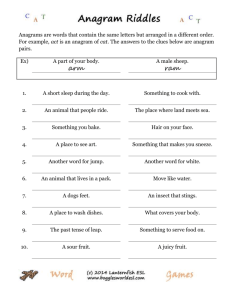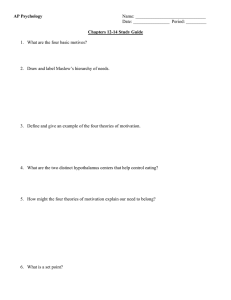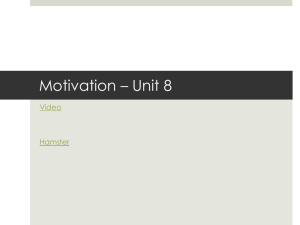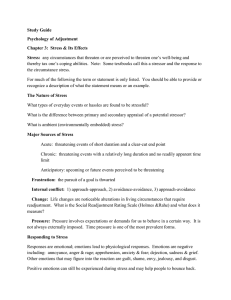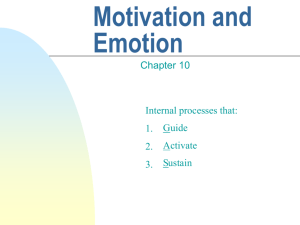of Vay ana Cognitive Performance J-{onors 'Thesis (J-{O:N7{S by
advertisement
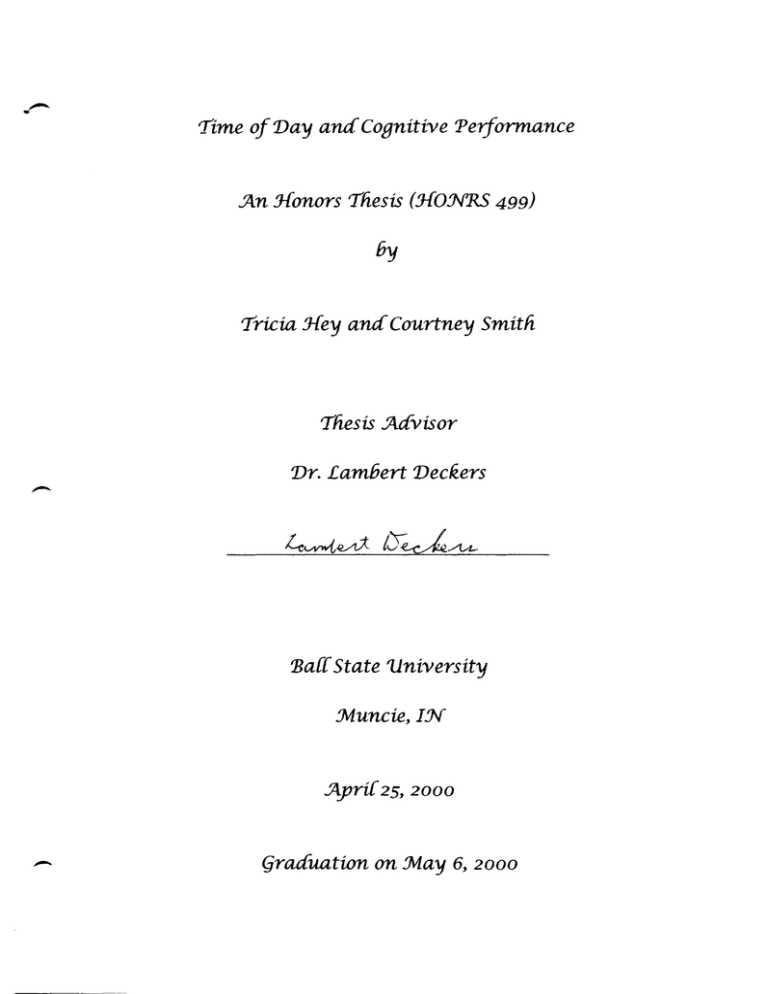
~rime
of Vay ana Cognitive Performance
~n
J-{onors 'Thesis (J-{O:N7{S 499)
by
'Tricia J-{ey ana Courtney Smith
'Thesis .Jti;{visor
Vr. Lambert Veckers
13a{{ State 'University
Muncie, IN
~yri{ 25, 2000
(jraauation on May 6,
2000
LD
~1f%~!
, Z-4
Table of Contents
')00 0
.#4q
-
1
Acknowledgements
2
Abstract
3
Introduction
4
Method
5
Results
7
Discussion and Conclusion
10
References
12
Appendix A
18
Appendix B
5tcknowCecfgements
We wouCd {ike to thank 'Dr. 'Deckers for aCC liis lie[p,
we wouCd aefiniteCy never have gotten tlirougli tliis
witliout you! 5tlSo, thanks to Casey Camp6eC{, Lanesliia
Casey, ami" (jretclien J{endrickson for gatliering our data
witli us . .:Jt syeciaCtlianks to Cooksey and'Dr. Joanne
Edmonds for givina us ideas, ayyroving our toyic, and
just 6eing there wlien we needed you!
Time of Day and Performance 2
-
Abstract
It is apparent that some individuals perform better on certain tasks as the day
progresses. Folkard (1975) found that as arousal increases throughout the day, so does
performance on immediate processing tasks. We tested this theory by administering
anagrams and sample ORE questions to ninety-nine participants. Our results were
similar to Folkard's results. Anagram solving performance significantly increased from 8
a.m. to 2 p.m; thus showing, that it may be beneficial for a student to take classes later in
the day as opposed to earlier in the day.
-
-.
Time of Day and Perfonnance 3
-
Introduction
In every day life one can observe loss of concentration, error in specific
performance, drowsiness, and many other behavioral changes as a result of the change in
time of day. Throughout our college careers it has been our experience that we are more
alert and responsive in our mid-day classes as compared to our earlier ones. We have
found that our arousal is higher later in the day, leading to better attention and
performance. As the day progresses further, we have observed that our arousal seems to
decrease after the lunch period, and then arousal increases again around the evening until
it is time to go to bed.
Beyond anecdotal evidence, prior research conducted by Clements, Hafer, and
Vermillion (1976) measured arousal in university classes that met at different times of
day ranging from eight in the morning to nine at night. They found that arousal steadily
-
increased until approximately 2 in the afternoon, after which there was a marked
decrease. It is because of these observations that one can conclude that there is an
apparent time of day where one performs tasks at an optimal level. Browne (1949) ran a
study on the performance of telephone operators at various times of day and found that
compared to the afternoon, subjects did significantly worse in the morning and later in
the evening, as measured by the number of errors committed. Simon Folkard (1975)
found that performance on different types of tasks is better at a certain time of day. His
studies on short-term memory suggest that performance improves slightly from early to
mid-morning, ,md then shows a decrease over the rest ofthe day. However, performance
on immediate component processing tasks, such as anagram solving, improves as the day
progresses.
These differences may be attributed to the increase and decrease in one's arousal
throughout the day. One's arousal is directly affected by internal factors such as body
-.
temperature and sleeping patterns (Thayer, 1989). These circadian rhythms cause arousal
to increase up to a critical point and then decrease in the late afternoon. It has been
Time of Day and Performance 4
--
theorized that wakefulness is highest in mid-afternoon due to the existence of a specific
circadian sleep/wakefulness rhythm (Gates, 1916). If we combine the time of day and
arousal studies, then we can conclude that performance is linked to arousal. It appears
that as arousal increases, then performance also increases. Further increase in arousal,
however, will lead to a decline in performance (Hebb, 1995). This relationship suggest
that is why arousal is highest at mid-day, which is the time when performance is the best.
Our Hypothesis
We hypothesize that as the day progresses, performance on cognitive tests will
increase. Our prediction is based upon the studies cited above. Participants were given a
series of problem solving tasks including anagram solving, analytical, and mathematical
questions at one of four different times a day. Folkard believed that performance should
improve due to increased processing speed with increasing arousal up to a critical point
when memory capacity has been reduced by the increase in arousal that it is no longer
capable of keeping up with the processing rate (1975). Anagram solving involves
immediate processing, while math questions as well as analytical problems rely more on
memory. If accuracy is seen primarily dependent on one's memory capacity, rather than
on the processing capacity, then it follows that as arousal increases through the day
accuracy should decrease; thus, the increase in anagram solving may be attributed to the
fact that it does not include a memory component.
Method
Participants
-
Our sample (N=99) consisted of thirty-eight men and sixty-one women enrolled
in introductory psychology at Ball State University. Their participation in this
experiment was a partial fulfillment of course requirements. The mean age of the
Time of Day and Perfonnance 5
-
participants was 20.28 years of age. Participants signed an infonned consent statement
prior to their participation.
Materials
To rate the participants' mood, two mood evaluations were administered by
experimenter. They were the State-Trait-Cheerfulness-Inventory Survey (STCI-18,
Ruch, Kohler, Deckers, & Carrell, 1994) and the Positive and Negative Affect Scale
(PANAS, Watson, et aI., 1988). A set often sample Graduate Record Exam (GRE)
questions were administered to measure cognitive perfonnance. A data sheet was given
to participants that included the participants sex, age, year in school, and the number of
hours of sleep that the participant had received from the previous night. The data sheet
also included the time of day the test was administered and what the climate was like for
that particular time and day.
-
Procedure
This experiment was administered at four different times a day (8 a.m., 10 a.m.,
12 p.m., and 2 p.m.) Participants were first given a data sheet, which included
demographic infonnation about them. The participants then completed the two different
mood scales. Next, the participants were given twenty minutes to complete the sample
GRE questions and anagrams. After the experiment was over, the experimenter thanked
the participants and debriefed them. The tests were scored for the number of questions
answered correctly and the number of anagrams solved accurately.
Results
Our research found that for the anagram solving task there was a significant time
of day effect, while there was slight influence on the sample GRE question scores. We
also found that women scored significantly better on the anagram solving section than did
--
our male participants. Finally, we found that students who signed up for the 12 p.m. or 2
p.m. testing times were more likely to show than those in the 8 a.m. and 10 a.m. testing
Time of Day and Performance 6
-
brackets. We also looked at mood and time of day using the PANAS scale, but no
significant results were found; therefore, this data was not analyzed further.
Figure 1 and Table 1 (Appendix A) shows the data for time of day and the performance
on anagram solving for the four different testing times. At 8 a.m. there was a mean
number of 26 cmagrams solved with a standard deviation of 4.6. At 10 a.m. there was a
mean number of28.52 anagrams solved with a standard deviation of 5.03. During the 12
p.m. testing time participants had a mean score of29.85 anagrams with a standard
deviation of 4.64. Finally, our 2 p.m. participants had a mean score of30.68 with a
standard deviation of3.38. We found the correlation between these scores and times to
be significant (r=.32, p<.OOI). Thus, as time of day increased, anagram scores increased
as well. The lowest number of anagrams were scored at our 8 a.m. testing time and the
highest were achieved at our 2 p.m. time. An analysis of variance indicated that means
-
were significantly different (F=3.87,p<.05). Overall subjects had a mean score of29.21
with a standard deviation of 4.59.
Figure:2 and Table 2 (Appendix A) illustrates the relationship between sex and
anagram solving. Males had a mean score of27.89 with a standard deviation of 5.2,
while the mean for the women was 30.03 anagrams correctly solved with a standard
deviation of 4 (F=5.29, p<.05). To compute a correlation, we coded women as 2 and men
as 1. The resulting correlation was found to be significant (r=.23, p<.05), which simply
means that women solved more anagrams than our male participants solved.
Finally we examined the show rates of participants who signed up and then actually
participated in our experiment. We found that it was more difficult to recruit people for
the 8 a.m. testing session. As is shown in Table 1, only about half as many people
participated in the experiment at the 8 a.m. time than at any other testing time. Figure 3
-
(Appendix A) shows the percentage of participants who actually showed up for their
experimental appointment. We found that a t 8 a.m. 53.3% of those who signed up
actually showed, while at 10 a.m. 47.6% showed. At 12 p.m., 92.6% of the participants
Time of Day and Performance 7
-
showed, and at 2 p.m. the numbers went back down to 84%. Thus not only were people
less likely to sign up for the 8 a.m. testing time, they were also less likely to show up if
they did.
Discussion and Conclusion
Our results support our hypothesis that students will perform better on cognitive
tests later in the day as opposed to earlier times. For instance, students solved more
anagrams later in the day than they did earlier in the day. While we found a slight
correlation between the GRE questions and time of day, the results were not significant.
Folkard (1975) attributes this improvement in performance to increased processing speed,
which in turn increases arousal as the day progresses up to a critical point. As the day
progressed participants' arousal increased, allowing them to solve anagrams more
accurately later in the day. The difference between the anagrams and GRE questions
may be attributed to Folkard's results showing that participants' performance on memory
tasks vary throughout the day. The GRE questions rely more heavily on memory
components than do anagram solving. Our findings that women scored significantly
better than men may be attributed to the fact that women tend to be more verbal than
men. This difference may also be attributed to the number of women participants, which
was twice the sized of the sample of men participants. Finally, we found that participants
were more likely to show at the 12 p.m. and 2 p.m. time slots for the experiment than at 8
a.m. and 10 a.m. This finding in part may be explained by arousal theory, which states
that as the day progresses up to a critical point, arousal also increases. Because of
increased arousal, a person would be more likely to attend to a commitment, and
therefore show up for an experiment. However, arousal theory alone does not explain our
findings.
Recent research on arousal theory shows that time of day may not influence other
variables that are thought to contribute arousal (Smith & Jones, 1992). Other variables
Time of Day and Performance 8
-
that we did not test that may have had an effect on our findings are the number of hours
the subjects have been awake as well as if they eaten prior to participating in our
experiment. Koulack (1997) found that people perform differently as a function of both
how long the participants had slept the night before the test as well as how long they had
been awake before being tested. Our study did test for a correlation in performance and
number of hours of sleep, but found no significant relationship between the two variables.
This phenomenon known as "the post-lunch dip" was also not tested. Thus, the result of
poor anagram performance at 8 a.m. is not due to lack of sleep. Previous studies have
also shown that there is an effect of eating on performance. However, Christie and
McGrearty (1979) found that tasks that last a short period of time do no often show this
effect. Because our participants were only given twenty minutes to complete their
questions, whether they had eaten or not eaten prior to the experiment most likely did not
-
have any effect on their performance.
Our study also lacked the consideration of individual differences among subjects.
Participants may have been either a morning or evening type of person, or they may have
been extrovertt:~d or introverted (Folkard, 1983). Introverts have a slightly higher body
temperature in the morning than do extroverts, which is why introverts are considered to
be more aroused than extroverts. The reverse is true in the evening; introverts tend to
have a slightly lower body temperature in the evening than do extroverts. Colquhoun
(1960) found that performance of introverts was better than that of extroverts at 10 a.m.,
and extroverts performed better at 3 p.m. The number of introverts and extroverts may
have skewed our results.
Another factor that was overlooked in our study is the accountability of activity
before a task is performed may alter performance due to interference and facilitation
--
(Fergusen, 2000). Negative transfer is one interference that may playa role in poor
performance. Participants who studied math problems that were different from the math
questions in our experiment may have interfered with their performance on the latter.
Time of Day and Performance 9
-,
While some prior activity may cause a decrease in performance, some prior activity may
facilitate performance. If a participant had recent practice in anagram solving, they could
have an increased score.
Our study did not test subjects past 2 p.m., which is around the critical point where
arousal decreao;es that was found by Folkard (1975). Thus we found a steady increase
without the dip in performance and consequent rise later in the day that been found by
previous experimenters (Smith, 1987). We also had a low number of participants at 8
a.m. as compared to our other three testing times, which may be due to the fact that
college students simply have different sleep cycles than most of the popUlation and most
often try not awake that early in the morning. This would account for the low percentage
of participants showing up earlier in the day.
Overal1, our study may be of use to students who want to perform their best on
-
exams by showing them that mid-afternoon is the peak of their performance and therefore
the optimal time to schedule their classes. However, students should keep in mind that
research has shown that different academic subjects are learned better at different times.
Colquhoun (1960) found, as did Folkard (1975), that short-term memory decreases in the
afternoon. He found that students may have trouble relating pieces of information and
learning new concepts in the afternoon; however, he also found that student's pay more
attention to the meaning of ideas later in the day. We may conclude that the best time to
teach or learn a subject depends on the nature of the subject and how it is taught.
References
Browne, RC. (1949). The day and night perfonnance of teleprinter switchboard
operators. Journal of Occupational Psychology, 23. 121-126.
Christlle, M.J., & McBrearty, E.M.T. (1979). Psycholphysiological investigation
of the post-lunch state in male and female subjects. Ergonomics. 22. 307-323.
Clements, P.R, Hafer, M.D., & Vennillion, M.E. (1976). Psychometric, diurnal,
and electrophysical correlates of activation. Journal of Personality and Social
Psychology, 33 (4), 387-394.
Colquhoun, W.P. (1960). Temperament, inspection efficiency and time of day.
Ergonomics. 3... 377-378.
Fergus.on, E.D. (2000). Motiyation: A biosocial and cognitive integration of
motivation and emotion. New York: Oxford University Press.
Folkard, S. (1975). Diurnal variation in logical reasoning. British Journal of
Experimental Psychology: General. 109. 32-4l.
Folkard, S. (1983). Diurnal variation. In Hockey, G.R.J. (Ed.), Stress and
Fatigue in Human Performance (pp. 247-269). Chichester: Wiley.
Gates, AI. (1916). Variations in efficiency during the day, together with practise
effects, sex differences, and correlations. University of California Publications in
Psychology. 2 .. 1-156.
Hebb, D.O. (1955). Drives and the C. N. S. (Conceptual nervous system).
Psychology Rc~iew, 62. 243-254.
Koulack, D. (1997). Recognition memory, circadian rhythms, and sleep.
Perceptual and Motor Skills, 85 (1), 99-104.
Ruch, W., Kohler, G., Deckers, L., & Carrell, A (1994). The State-TraitCheerfulness-Inventory <Fonn STCI-18>. Unpublished manuscript, University of
Dusseldorf, Gennany.
Smith" AP. (1987). Task-related motivation and time of testing. In R.
Schwarzer, H.M. Van der Ploeg, & c.D. Spielberger (Eds.), Advances in test anxiety
research. Vol. 5 (pp. 115-123). Berwyn, Pennsylvania: Swets North America.
Smith, AP., & Jones, D.M. (Eds.). (1992). Handbook of human perfonnance:
Vol. 3. New York: Harcourt Brace Jovanovich.
Thayer, R.E. (1989). The biopsycholoID' of mood and arousal. New York:
Oxford University Press.
Watson, D., Clark, L.A, & Tellegen, A (1988). Development and validation of
brief measures of positive and negative affect: the PANAS scales. The Journal of
-
Personality and Social Psychology. 54. 1063-1070.
•
ppen IX
-
)
)
)
Time of Day and Problem Solving
35
30
25
"'C
Q)
.2:
o
en
20
(/)
E
!!!
~
~
15
10
5
0+1--.....
8a.m.
12 p.m.
10 a.m.
Time
Figure 1. Mean number of anagrams solved at the four different testing times.
2p.m.
Time of Day
N
Mean Standard Deviation Minimum Maximum
8 a.m.
13
26
4.6
13
31
10 a.m.
29
28.52
5.03
17
37
12 p.m.
26
29.85
4.64
23
39
2 p.m.
31
30.68
3.38
25
36
All Cases
99
29.21
4.59
13
39
Table 1. Time of Day and Anagrams Solved
II)
iii
E
II)
LL
uQ)
>
0
en
(/)
E
a:J
~
en
a:J
c
«
"-
">
0
CD
~
Q)
0U)
.0
til
Z
E
::J
E
l!
C)
0Q)
~
~
0
ca
u
~
.£
"cca
.£
)(
cQ)
c
Q)
(/)
Q)
0
CD
~
U)
&
is
x
Q)
en
II)
iii
::E
N
Q)
~
::J
en
i.L
Sex
N
Mean Standard Deviation Minimum Maximum
Male
38
27.89
5.2
13
37
Female
61
30.03
4
18
39
All Cases
99
29.21
4.59
13
39
Table 2. Sex and Number of Anagrams Solved
)
)
)
Time of Day and Percentage of Shows
100.00%
90.00%
80.00%
"0
70.00%
~Q.
U
t!as
60.00%
D.
0
.t:.
s:
a
=?c
Q)
en
50.00%
40.00%
'0
"ate
30.00%
20.00%
10.00%
0.00% +1- - - - - '
8 a.m.
12 p.m.
10 a.m.
Time
Figure 3. Percentage of Subjects that Participated in Experiment After Signing Up
2 p.m.
•
ppen IX
B
3
-
-
INFORMATION FOR SUBJECT AND INFORMED CONSENT
This psychological research project is called "Mood and Problem Solving." Your task will
be to fill out two questionnaires that measure your current mood states. This will be followed by
completing some problem solving tasks and by rating some cartoons for how funny they are to
you. This entire task of filling out two psychological scales, solving problems, and rating cartoons
will take about 35 minutes of your time. You will receive one hour of credit toward fulfilling
General Psychology (pSYSC 100) course requirements for participating. You will be fully
debriefed at the conclusion of this session.
You will not write your name on the scales, the problem sheets, and the cartoon rating
sheets. All the data will be kept completely anonymous.
There is little risk for participating in this study although you may find the questions
invade your privacy and that the problems may be difficult to solve. However there are several
benefits that can bt~ expected from participating in this study. You will gain first hand information
about psychological research, about your moods and how they are measured. You may also gain
some insight into your own behavior, such as the relationship between moods, problem solving
and humor.
Participation in this study is voluntary and you are free to withdraw your consent and to
discontinue participation in this study at any time without prejudice from the investigator. You
will still receive the one hour of credit toward fulfilling course requirements for General
Psychology (pSYSC 100).
Please feel free to ask any questions of the investigator before signing the consent form
and beginning the study, and at any time during the study.
Forone's right as a research subject, the following persons may be contacted: Ms. Sandra
Smith, Coordinator of Research Compliance, Office of Academic Research and Sponsored
Programs, Ball State University, Muncie, IN 47306, (765) 285-1600 or the chairperson of the
Institutional Review Board.
• ••• **.******************
Informed Consent Statement
I,
agree to participate in the psychological study called "Mood
and Problem Solving." I have had the study explained to me and any questions I may have had
were answered to my satisfaction. I have read this description and give my consent to participate.
In understand that I will receive a copy of this Infonned Consent form to keep for future
reference.
Participant's Signature
--
Principal Investigator
Lambert Deckers
Department of Psychological Science
Ball State University
Muncie, IN 47306-0520
(765) 285-1706
Date
DATA SHEET
TIME OF DAY_ _ __
DAY OF THE WEEK- - - WEATHER (cloudy, sunny, snowing, rain, temperature)
NUMBER OF HOURS OF SLEEP_ _ __
EXPERIMENTER_ _ _ __
NUMBER OF ANAGRAMS SOLVED
----
SCORE ON GRE STORY QUESTIONS_ _ _ __
-
TIME WORKING ANAGRAMS + GRE QUESTIONS_ _ __
SUM OF FUNNINESS ON
p.l _ _
p.2._ _
p.3_ _
SCORES ON STCI-S-18
cheerfulness- senousness _ _
bad mood , - PANAS
positive mood score_ _
negative mood score_ _
J
--
\
-
PARTICIPANT INFORMATION SHEET
SEX: M
F
AGE:._---YEAR IN SCHOOL_ _ __
TIME YOU WENT TO BED LAST NIGHT_ _ __
TIME YOU WOKE UP TODAY
----
-
',' .... ' ..
-
STCl-S-lS
Instructions: The following statements refer to your curreut mood and mental state. Please try as
much as possible to descnbe your current feeliDp and state of mind by circling one of tile four
alternatives. Please use the following scale:
1. strongly disagree
3. moderately agree
2. moderately disagree
4. strongly agree
For example:
I have an even temper .............. I
2
3
4
If you stronliY qree with this statement, that is, if you have an even temper at this moment, ~irde 4.
If you strongly disagree, that is, if you at praeat do not have aD even temper at aU, drde 1.
If you have difficulty answering a question, pick the solution that most applies.
SInIsiIY . . .
SIraqIy Dill.,..,.
-1. I feel gloomy ..................................................... 1
2. I am set for serious things................................... 1
3. I am cheerful...................................................... 1
2
2
2
3
3
3
4
4
4
4. I have important things on my mind.................... 1
S. I am in a crabby mood ........................................ 1
6. I am sad............................................................. 1
2
2
2-
3
3
3
4
4
4
7. I am ready to have some fun.............................. 1
S. I have a serious mental attitUde.......................... 1
9. I could laugh at the dropofa hat....................... 1
2
3
3
3
4
2
2
3
3
3
4
4
12. I regard my situation objectively and soberly ..... 1
2
2
2
13. I am amused '" ...... ........... ........... ...................... 1
14. I am in a serious frame of mind .......................... 1
IS. I am in a thoughtful mood ................................. 1
2
2
2
3
3
3
4
4
4
16. I feel dejected .................................................. 1
17. I am delighted ............................................ ,..... 1
IS. I feel grouchy.................................................... 1
2
2
2
3
3
3
4
10. I am peeved (annoyed)....................................... 1
11. I'm walking on air.............. ................. .......... .... 1
Please check to see that you have answered every statement.
-
4
4
4
4
4
-
-
.
..
'lbis scale CCXlSists of a I11.Itber of words that describe different feelings ani
enotions. Read each item and then circle the appxq>riate answer •. Indicate to \<\bat
extBlt ycu feel this way right now, that is, at the present m:ment. Usetbe
following scale to recoro your answers.
very slightly
a little
mXiemte1y
quite a bit
extremely
or not at all
-
1. interested
1
2
3
4
5
2. distressed
1
2
3
4
5
3. excited
1
2
3
4
5
4. upset
1
2
3
4
5
5. strong'
1
2
3
4
5
6. guilty
1
2
3
4
5
7. scared
1
2
3
4
5
8. }x)stile
1
2
3
4
5
9. enthusiastic
1
2
3
4
5
10. proud
1
2
3
4
5
11. irritable
1
2
3
4
5
12. alert
1
2
3
4
5
13. ashamed
1
2
3
4
5
14. inspired
1
2
3
4
5
15. nervous
1
2
3
4
5
16. detennined
1
2
3
4
5
17. attentive
1
2
3
4
5
1
2
3
4
·5
19. active
1
2
3
4
5
20. afraid
1
2
3
4
5
18.
-
jit~
STOP
DO NOT TURN THE PAGE
WAIT FOR FURTHER INSTRUCTIONS
-
,-
ThE! following questions are a set of two related words. Choose the answer
that best expresses the relationship in the original set of words.
1. CRINGE:FEAR
a. gasp:breath
b. tbink:conclusion
c. yawn:boredom
d. enhance:nobility
e. announce:reaction
2. PLANT:FERTILIZER
a. animal:food
d. season:hunting
c. harvest:plenty
b. rose:thorn
e. restaurant:menu
3. BOAST:VANITY
a. gloat:satisfacioil b. write:novel
c. primp:humility
d. apologize:profit
e. mail:photograph
4. ECSTASY:PLEASURE
a. hatred:affection b. condemnation:approval
c. rage:anger
d. difficulty:understanding
e. privacy:invasion
-
5. ACCIDENTAL:INTENTION
a. ,roluntary:req~iremel1t b. anticipated:performance
c. ioteresting:feeling
d. practical:knowledge
e. insane:correction
6. If x = 2, what is the value of x +2x - 2?
a. -2 b. 0 c. 2 d. 4 e. 6
7. If (2 +3)(1 + x) = 25, then x =
a. lOb. 8
c. 1
d. 4
e. 5
8. Ifx + y = 3, then 2x + 2y =
a. 2/3
b. 112
c. 2/3
d. 6
e. Cannot be determined from the information given
9. Diana spent 112 of her allowance on a book and another $3.00 on lunch. Ifshe
still had 1/6 of her original allowance, how much Is Diana's allowance?
a. $24
b. $18
c. $IS
d. $12
e. $9
10. Waking at a c.onstant rate of 4 milesr r hour, it takes Jill exactly one hour to
walk home from school. If she walks at ~onstant rate of 5 miles per hour, how
many minutes will the trip take?
.
a. 48
b. S4
c. 56
d. 72
e. 112
~
Unscramble the letters to make a word. Write the solution on the line.
CTA_____
TPI._ __
ETN_ _ _,
ONT_ __
WNO_ __
Mrn._ _..NYA_ _ __
EWN._ _ __
YDA______
ANM._ __
ATPR____,
DMAE._ _
TMSO_._ _
AEMS,_ __
SUDE_ _ _.
IEGV_ __
AFEC_ __
TLSA____
ENDE._ __
ATCF_ _ __
TESLA
'----
IGTHN_ __
AETKN_~
OEYNM___
GENBA___
ECLAP_ __
TWEAl._ _
NMUHA:....-_ __
ONNWK._ _
UESHO_ _ __
NDUTER.~_
EEROBF_ _.
AYASWL._ _.
BDNIEH._ _ __
TCOAIN
--
EMNMTO_ _
-,
n.SACO_ __
NDGIRU_ _
LOHCOS _ _
--_.
UBPCLI
